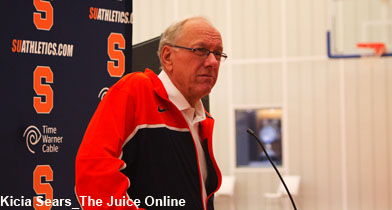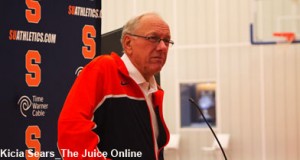
Historically, a Syracuse team that loses as much talent as departed from last year’s Elite-Eight squad can expect to win far fewer games the following season, perhaps just 22 barring a Wesley Johnson-esque surprise. But just because the 2012-2013 Orange will have a difficult time reaching the 34-win plateau, that does not mean it will not outshine last year’s team in many aspects of the game.
Let’s examine 3-point shooting.
One might think that having Trevor Cooney replace some of Scoop Jardine’s minutes will make this year’s Orange a bigger threat from the outside. However, between Kris Joseph, Jardine and Dion Waiters, Syracuse loses 58.7 percent of its made 3-pointers from last year. The Orange returners (excluding Cooney and the freshmen) shot just 33.8 percent from long distance.

Cooney could go a long way in making up that gap. In actual game experience, we only have his 2-3 performance in last year’s two exhibition games to judge, but the coaching staff has said Cooney added several pounds of muscle to his frame in the off-season and continues to shoot the lights out in practice.
» Related: The Post-Standard’s Mike Waters breaks down the upcoming season
Still, if this year’s Orange is to improve on last year’s 35-percent shooting from behind the arc, Brandon Triche and James Southerland will need to shoot more consistently. Triche shot 35 percent on 3s last year – almost exactly the team average. But during his first 12 games, he managed to make 40 percent of 82 attempts. He followed this with 18-percent shooting the next 12 games on just 32 attempts.
Southerland also struggled with consistency. He shot 40.7 percent in his first 18 games before slipping to 14.7 percent his next 12. He finished strong, going 10-22 in the Orange’s final seven games, but the question is which Southerland will show up next season.
If Southerland and Triche can perform more consistently, adding Cooney to the mix will make next year’s Orange a far more dangerous team from the outside.
Rebounding is another area where this year’s Orange has room for improvement. The biggest knock on last year’s team throughout the season was that they gave up too many second-chance opportunities. The orange’s defensive rebound percentage was just 60.4 percent, ranking them 342nd in the nation.
To a large degree, Syracuse overcame its poor rebounding last season by forcing 16 turnovers per game at a rate of 24.4 percent of possessions. This year’s team may have difficulty matching the defensive presence of Waiters and Fab Melo, but it could make up the difference by corralling more missed shots.
» Related: Meet SU forward CJ Fair
Despite receiving criticism for his rebounding at times, Southerland actually had a higher defensive rebound percentage than Kris Joseph – 15 percent to 10.7 percent. Rakeem Christmas similarly outshined Melo from a statistical perspective, collecting 17.4 percent of available defensive rebounds compared with 13.4 percent by Melo.
To some degree, these higher percentages would likely have fallen had Christmas and Southerland played as many minutes as Joseph and Melo. But the potential is there for the 2012-13 Orange to be a much better defensive-rebounding team.
The biggest reason why this year’s Orange will improve its rebounding is 275 pounds and named Dajuan Coleman. The five-star freshmen is expected to join the starting line-up straight away, and he will provide the bulk the Orange has lacked since the graduation of Arinze Onuaku.
It is always difficult to project how a freshman will adjust to the college game, but the 14.1 rebounds per game he averaged for Jamesville-DeWitt High School his senior season suggest that his presence will be felt immediately.
Coleman also managed to snag a game-high 12 boards in the McDonald’s All-American game, a difficult feat in an all-star game focused around fast breaks and minimal defense.
» Related: Brandon Triche to play big role for Syracuse
Finally, Syracuse’s guards will also contribute to improving the team’s rebounding. Michael Carter-Williams, the projected starting point guard, recorded an 11.5 defensive rebound percentage, which is especially high for a guard. In comparison, Jardine’s and Waiters’ percentages were 8.3 and 8.1, respectively.
Carter-Williams also uses his 6-6 frame to pull down rebounds at the offensive end. He corralled 3.9 percent of available offensive boards in limited time, just slightly less than Waiters and Jardine combined (4.1 percent).
All-in-all, the Orange will play a very different style of basketball this season. The team will improve its 3-point shooting and rebounding, and this will lead to a more successful half-court offense.
We won’t see as many highlight-reel fast-break dunks, but in the end, this new version of the Orange may be better suited for a deep run in the NCAA tournament.
For more Syracuse coverage, Like our Facebook page and follow us @TheJuiceOnline.

